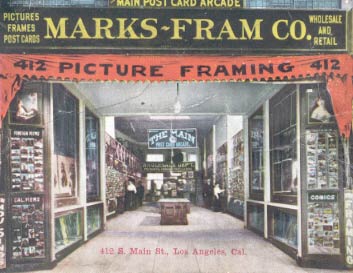
A Visit to Old Los
Angeles
4. Main Street (Part
2).
Copyright © Brent C. Dickerson
Index to Episodes (click here).
Main Street, Fourth Street to Eighth Street.
• Young Frederick Johan would spend many a stray moment over the next week picking out postcards at the Marks-Fram Co., 412 S. Main Street.

• We looked back and had a vision of what the southwest corner of Main and Fourth Sts. looked like before the Farmers & Merchants Bank was built there. The large roof sign calling folks to the Hotel Van Nuys on Main Street is "aimed" at the train stations east towards the river.

• Main Street near Fifth Street, looking north. The buildings immediately to our right are relatively new, having replaced the old Post Office building; we shall be seeing the new Post Office building shortly, when we begin our walk down Spring Street. The building at the right edge of this view, of which we see just a sliver, is the Canadian Building, built in 1909.

• Here is the same scene on Main a decade or two earlier; the old Post Office is the large building on the right, built in 1893; to orient yourself, note the cupola on the building which is in the background in both views; in the far background in this older view can be seen the tower of the Westminster Hotel. Those dark structures to the left are things called "trees," always treasured by residents of Los Angeles, and even rarer there now than then.
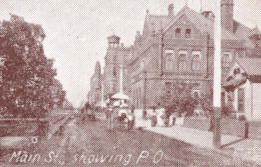
| • The Oriental Café is at the left in this view; on the west side of Main Street, it's about half way between Fourth and Fifth Sts. |  |
• I was very curious to see the Los Angeles version of Oriental splendor—Minnie declared that she had no doubt, no doubt whatsoever, that, the moment I stepped in there, I would be sold into white slavery and shipped in chains to Formosa; but I said, "That's my queue!", and opened the door to a scene which, if not quite Oriental, was certainly exotically bright.
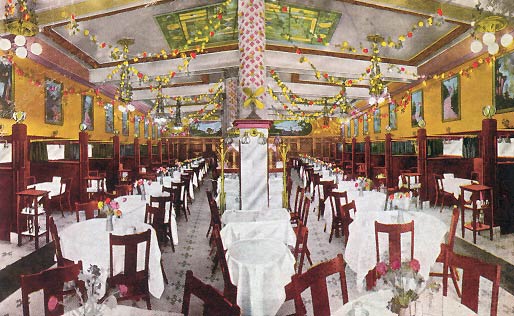
• My having escaped the
clutches of white slavery, we all stood at the southeast corner with Fifth
Street and gazed north along the west face of Main.
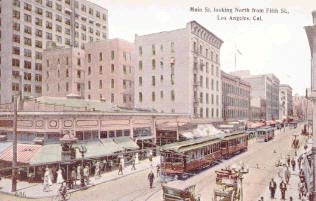
• And now, let us cross to the southwest corner with Fifth Street, and look north along the east face of Main. "Need we really be quite so thorough?", asked Mother.
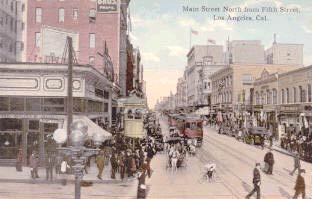
• Instead of answering, Papa abruptly grabbed my shoulder—I was nearest to him, you see—and I followed his gaze to a sign in the window of a shop on the northeast corner: Belmont Bar and Cigar Store.
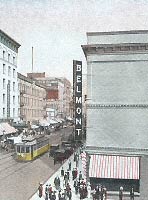
• Mother saw what had gained our attention, and sighed deeply as Papa, Charley, and myself walked in. Behind on the street, I could hear Anna say, "Never mind; it's much fresher out here." "And I should imagine that the men are much fresher out here too," added Minnie, as Mother sighed again. Inside, the atmosphere was dim and close. As Papa made his choices among the cigars to be had, and Charley tippled at the bar, I scrutinized the place, and made a curious discovery. "Charley," quoth I, "there's something odd here." He looked about—rather half-heartedly, as I thought. "What might that be, Ulf?" "Look in the mirrors. They only reflect in black and white." As we stared and attempted to account for this phenomenon, Papa gathered us up and rushed us along; "the ladies are waiting!", said he.
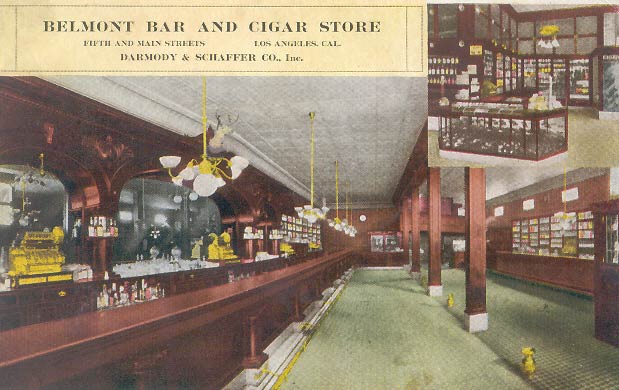
• To the right below, the corner kitty-corner to the Belmont—that is, the southwest corner of Main and Fifth Sts., and west up Fifth towards Spring and Broadway. To the left below, just a few doors down at the building housing the Hotel Brennan upstairs, and storefronts below. The Hotel Brennan was "new" in December, 1905; it lodged a protest against "Itinerant Christians and loud-smelling tamale wagons."
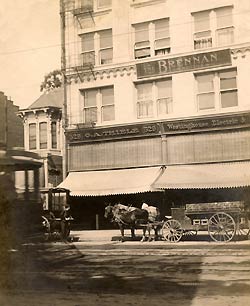 | 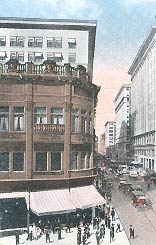 |
• A detail from the above image of the Hotel Brennan. A delivery boy waits at the rear of his wagon; horses wait at the front of theirs.
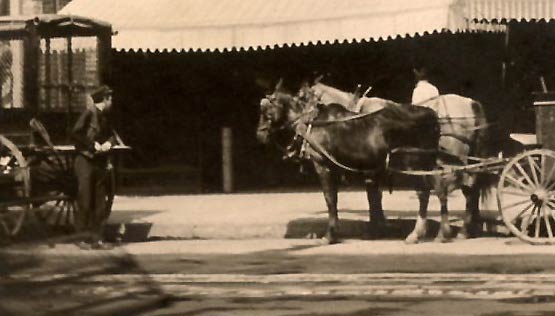
• We turn from looking west to looking south, and look down Main to the corner with Sixth and beyond. The low two-story building in the foreground on the left is the Burbank Theater, built by the founder of the city of Burbank, David S. Burbank (a dentist, and no relation to the horticultural wizard Luther Burbank). Dr. Burbank's home, formerly on this site when Main Street was a residential street, was now in the city of Burbank on acreage which would later become the Warner Bros. Studios. The tall building beyond is the Kerckhoff Building, which we'll see from a better angle in a moment.

• A head-on look at the Burbank Theater. "I see that that gripping drama My Wife's Husband is playing," said I. "Ja," said Papa, "it sounds more like my wife is playing!" Mother reddened. "Mind your public comments, Mr. S.! If you would be so kind!"
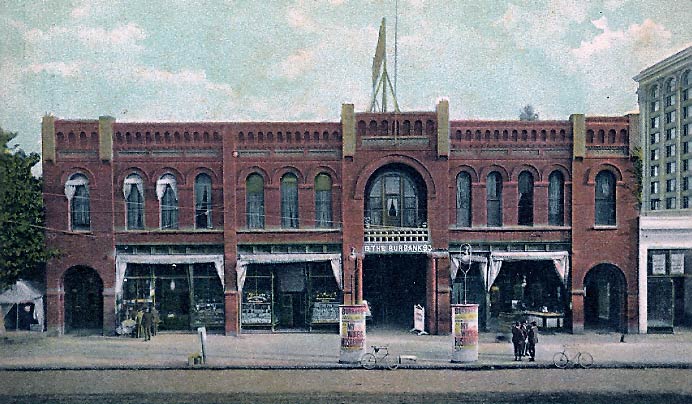
• And here are Dr. Burbank's across-the-street neighbors' houses, giving an idea of the flavor of Main Street when it was still suburban and residential at this point. From the south, we see most of the west side of the 500s block. Main's corner with Fifth Street is near the upper right corner of this view; the white building at the upper left-hand corner is at the northeast corner of Spring and Fifth Streets. The buildings in the right foreground of the view two back replaced these charming Victorian residences and their greenery.
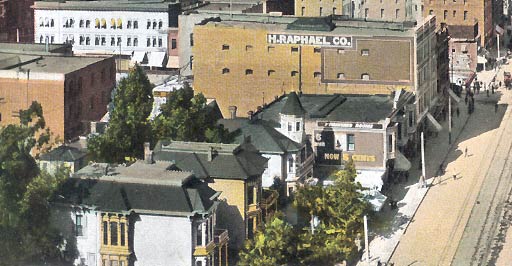
 | • Back to modern urbanized Main Street! Here is the better side of the Kerckhoff Building, at the northeast corner of Main and Sixth Streets. |
• The Kerckhoff Building replaced much more modest structures on that corner. We see the Burbank Theater at lower left, but the overwhelmingly dominant structure up ahead is the Pacific Electric Building on the southeast corner of Sixth and Main.
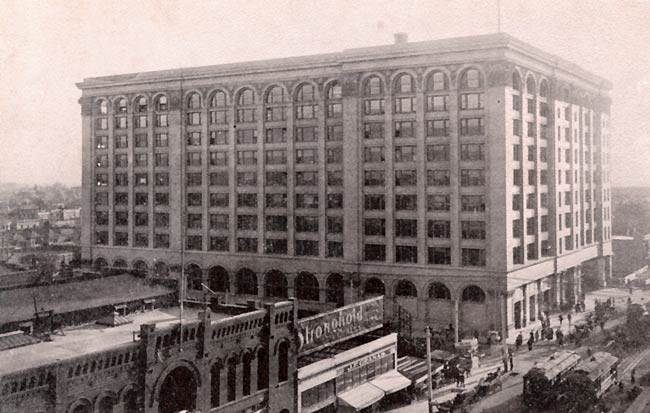
• The Pacific Electric
Building was known also as the Huntington Building. It was the city's
first nine-story building. Main Street goes southwards off to the right;
Sixth Street goes eastwards towards Los Angeles Street and, eventually the
river, off to the left. We see that we are at the growing edge of
downtown—that is the residential neighborhood being pushed out on
either side of the building.
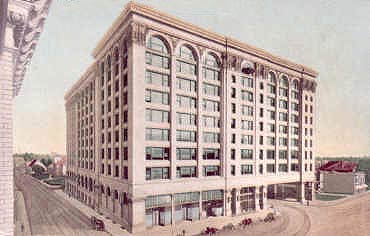
• Inside the Pacific Electric Building is the Pacific Electric Grill.
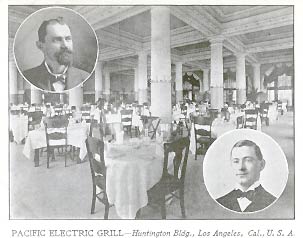
• The Central Building is located on the southwest corner of Main and Sixth.

• And here are the southwest and northwest corners of Main and Sixth; we look west on Sixth Street from Main. That's the Central Building on the left. As we shall see, Sixth Street was popular with postcard photographers, as was Third Street; meantime, streets such as Second were largely ignored.
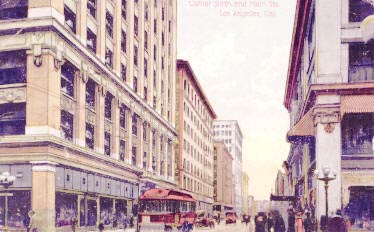
• The L.W. Blinn Lumber Company would like us to take a few steps east up Sixth Street so that we can properly admire their offices at the northwest corner of Main and Sixth.
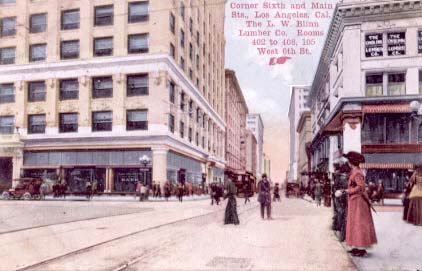
• From on high, we look west on Sixth from Main towards the corners with Spring, Broadway, Hill, and beyond. Central Park, later to be named Pershing Square, can be glimpsed as the green area just beyond the buildings on the right of the illustration. The tall white building prominent on the right is the Los Angeles Trust and Savings Bank on Spring; the squat brick building across the street from it is the Hotel Hayward; immediately on this side of the Hotel Hayward is the building on Spring housing the offices of the Southern Pacific Railroad; and, at the left of our view here, a portion of the Central Building on Main lifts its arcaded head over the surrounding buildings.
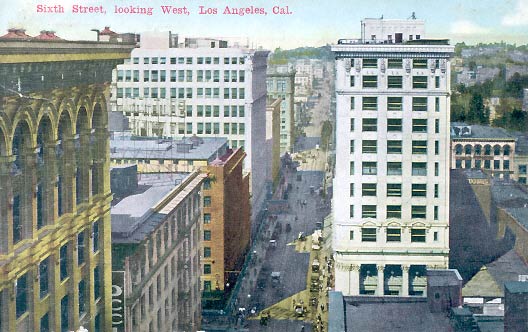
• No part of Main Street is more bustling than the part in front of the Pacific Electric Building!

• Main Street between Sixth Street and Seventh Street, looking north from street level. The wall-sign at the upper right of the view reads in full: "I say your credit is good here!". We saw the "G" of the "Central Bldg." in the previous picture.

• But let's take in the view
north up Main Street from the top of the Pacific Electric
Building.

 | • Now, from the same vantage point, we turn a little more easterly to see the blocks between Main Street, at our left, and the unseen Los Angeles Street. The large brick building at center is the one with the cupola which we noticed earlier (the cupola is hard to make out in this view), with the Westminster Hotel just beyond, and the spire of St. Vibiana's just beyond that. |
• Young Frederick Johan,
declaring that his lucky number was 7, insisted on running another block
to Main and Seventh, where he looked west down the latter street to see
its successive corners with Spring Street and
Broadway.
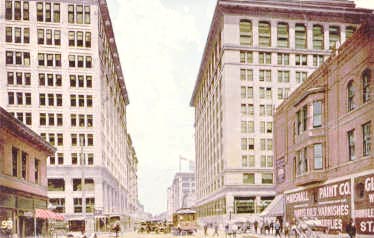
• On the southeast corner of Main and Seventh, FJ found the bargain furniture store J.M. Overell's. "Bargain!," he sniffed, "If a person wants to save money, the best way is to keep it in your pocket."
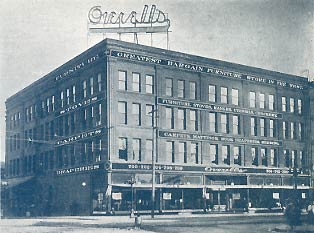
• But of course you know young FJ, who when he is only going another block to look at Main and Seventh, returns by way of Eighth... The Hotel Huntington, built in 1910.
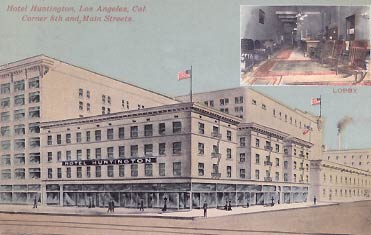
Go back to Main Street (Part 1). or Go on to Spring Street (Part 1).